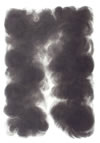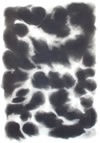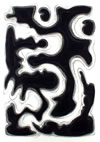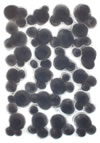 "Tumbleweed"
"Tumbleweed" |
Two things are immediately evident
about Michael Kaniecki’s art when glancing at his work
on display at his home/studio; first, he’s hard to
peg, and second, he’s got enough talent to defy being
pegged.
Kaniecki’s art ranges widely in subject matter, color palette, medium
and size. He seems comfortable with and curious about visual art in a myriad
of forms. Through his work, he has explored creating nudes, landscapes,
still lifes, and abstracts.
Many of his drawings are
monochromatic, or nearly so, and he has created several ink
drawings using bold hues of red and black. A little of his
work also features vibrant colors. The work he has done and
exhibits in his home is done in paint, pastel, ink and charcoal.
The one continuity I perceive in Kaniecki’s art is a fluidity with
lines and shapes. Although he uses color effectively within the works that
are polychromatic, he displays a penchant for contours.
This preference becomes obvious in the drawings and paintings he has done
in the last year since he arrived in Moab. Where most painters who become
inspired by the dramatic scenery around us regale themselves in vibrant,
multi-hued palettes, Kaniecki’s landscapes are primarily in black
and white.
The scenery is recognizable even as Kaniecki shifts from representational
art to more abstract. The angles, shapes and contours recogni zable
to this area surface in his work, but the actual image is more difficult
to define and the end result may remind the viewer of this area, but not
of a specific locale.
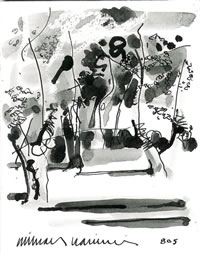
"City Park" |
This quality is evident in the ink wash entitled “City
Park” (shown), as it walks the fine line between representational
and abstract. The most outstanding features are the quick vertical lines,
which are surrounded by various shapes ranging in tones. There is a resemblance
to trees shading a park, but it is the title that suggests that image.
Kaniecki’s current interest is moving him into abstracts. He attributes
his readiness to explore this form to his perception that it allows him
to be more intuitive, less conscious, or as he puts it, “it lets
the marks speak.”
He recently finished a four part series in charcoal entitled “Creation” (shown),
which depicts the metamorphosis of a plume of mist dividing and separating
an amorphous inky cloud. In each drawing, the transition reaches a new
level, reminiscent of text book images of cell division. This series
was inspired by a dream he had and the naturally flowing shapes and curves
reflect this tendency of the artist to allow the marks to speak for themselves.
Another manifestation of this shift towards the abstract in Kanieck’s
current work is the series he has done on tumbleweeds. Fascinated by
this dried plant and it’s intricate patterns, he has explored this
subject in several mediums.
In one expansive work entitled “Universe” that measures 4
feet squared, Kaniecki depicts the tumbleweed with black charcoal, excepting
the center, which looks like a glowing red ember. A second work entitled “Tumbleweed” (shown)
is done in oil pastels, featuring reds and blues, and resembles a burning
bush, the tendrils of the dried tumbleweed snaking up like flames.
Kaniecki’s interest in patterns is a remnant of the decades he
spent in industrial design, starting with a job designing tires for Goodyear.
Although he always had a drive to pursue art, he felt family pressure
to “get a real job,” and like many like him, he segued his
artistic interests and talents into attaining a B.S. in industrial design.
This field eventually took him and his wife, Fredericka (or Freddie)
to Seattle, where they spent thirteen years. For part of the time, Kaniecki
worked for an ad agency owned by artists who employed other artists.
The job gave him a strong circle of friends who occasionally exhibited
or collaborated together. One exercise they pursued was to have an artist
begin a sketch and then hand it over to a second person to finish it.
Kaniecki says that this was an interesting idea to pursue as it allowed
him to “see how much you actually own your own work.”
Another aspect of working in industrial design that attracted Kaniecki
was the process of creating thumbnail drawings to explore a visual idea.
Because of its rapidity and lack of refinement, he found this process
relaxed and loose, allowing for a great deal of spontaneity, or as he
describes it, “it flows out of you.”
This influence is still easily evident in his current work, particularly
among the red and black ink drawings. Many of these feature tiny images
repeated several times, sometimes changed minutely by a line or a reversal
of color. Kaniecki explains that these are a result of an artist’s
exercise in which the drawer practices or explores making lines spontaneously
and then repeating the same lines. They are the artists’ version
of playing scales.
Unlike many accomplished artists, Kaniecki seems to still enjoy testing
and honing his manual skills. This willingness to commit himself to rote
exercises belies his real attitude toward art, which is a belief in passionate
self-expression. Again, a musical analogy comes to mind to explain this
balance; he is a visual jazz expressionist who is willing to master the
basic skills in order to use and manipulate them in his own impromptu
creations.
This improvisation explains the wide range of Kaniecki’s art. He
claims that he gets bored specializing in subject matter or mediums,
but the truth is, his abilities allow him to explore so many possibilities
that little time passes before a new idea calls to him and he follows
that path.
In addition to raw talent and honed skills, Kaniecki has freedom to pursue
his inspiration in art. By choice, he is not attempting to make a living
as an artist. In part, he doesn’t want to be limited to producing
what other people ask for. He recalls from his days as an industrial
designer the frustration of setting aside your own artistic interests
in order to create what is expected of you. The other reasons why he
chooses not to pursue the business side of art is that he is simply, “so
in love with the things I create.”
The possibility of exploring so many visual ideas keeps Kaniecki excited
and passionate about art.
His interest in art extends beyond producing it to thinking about the
process. Freddie describes him as “a bit of an art philosopher,” and
proof of this lies in a seven-step process entitled “The Artist’s
Path” that he uses to define the creative process.
He has also become an integral part of Moab’s burgeoning artist
community. He has joined the board of the Moab Arts and Recreation Center
(MARC) and has helped create the Artists Alliance, a group that is promoting
this town as an art destination.
|


